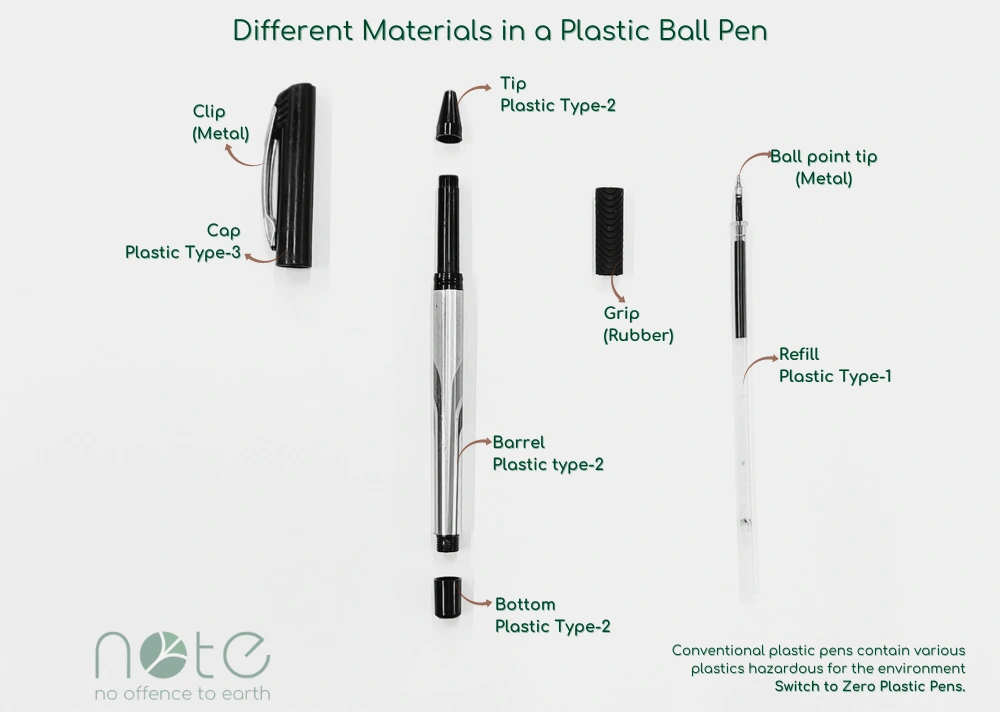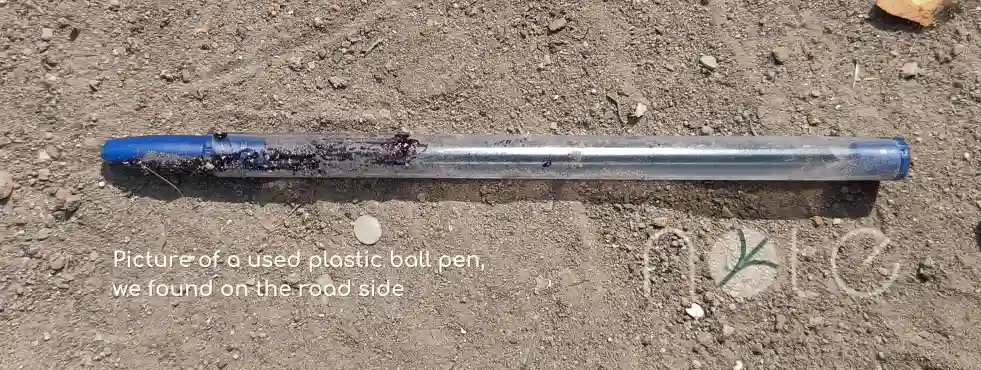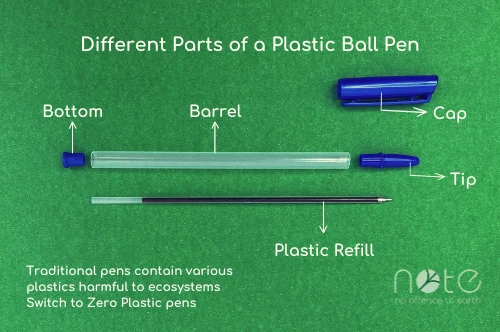

Where do my used plastic ball pens go?
This blog post deals with the major challenges faced in plastic ball pen recycling and why they are not a sustainable and eco-friendly option for the environment.
Can plastic pens be recycled?
Well, the short answer to this question is YES. It is indeed possible to recycle plastic ball pens.
But, is it easy to recycle plastic ball pens?
The answer is NO as the process of recycling pens is more complicated than it seems! Let’s find out why.
Reasons behind why plastic ball pens are not recycled:
Let’s do an exercise.
Pick up the pen kept on your desk and observe it carefully ! How many different parts can you in it?
The pen kept on my desk has 5 parts(the tip, barrel, bottom, refill and the cap).
It’s quite a simple yet complex piece of stationery , consisting of many small components such as the cap, the barrel, the ink cartridge, and the tiny ball at the tip.
Furthermore, each of these tiny parts is often made from different materials, we will read more on this on the next section.
Read more about this in the section about Low Recycling Rewards.
Now, let’s pick up that pen again and now look closely! What materials are those made up of ?
You will definitely spot more than one.
A plastic pen uses a variety of materials ranging from malleable metals to stable plastics.
Let me tell you more!
Different types of plastics: These range from Polypropylene copolymer to polyethylene for the packaging.

Brass: Known for its malleability and resistance to corrosion, brass is often used for creating the tips of ballpoint pens. The tip, where the ball rotates while writing, plays a crucial role in smooth ink flow.
Stainless Steel: Stainless steel components are used in various parts of the pen, including the clip and other small details. Its strength and resistance to rust make it a reliable choice.
Rubber: Some pens incorporate rubber grips or coatings for better comfort and grip. Rubber provides a non-slip surface, making it easier to write for extended periods.
Aluminum: Although less common, aluminum is occasionally used for pen bodies. It offers a lightweight feel and can be anodized for different colors and finishes.
Tungsten Carbide Ball: The ball at the tip of the pen, which transfers ink to the paper, is typically made of textured tungsten carbide. This material ensures smooth writing and durability.
As you saw above, these days, a gamut of materials are used in making plastic ball pens, which only further complicate the process of recycling pens and segregation for the next steps.
“Why aren’t people recycling these plastic ball pens then?”This was my question when I first came to know about all the problems in a plastic ball pen.
Well, answer isn’t as simple though.
Recycling the plastic components of a pen, like the barrel, is technically possible, but it’s no simple task.
To even start recycling, you must first take apart the pen to remove the ink cartridge and other non-recyclable parts.
Despite these efforts, many recycling centers are reluctant to accept pens.
In fact, the small parts are either not differentiable in the little or even if they are, rag pickers don’t bother to pick them up.
They are small, often lack clear recycling labels, and their mixed material composition makes them difficult to process efficiently.
As a result, plastic ball pens, no matter how dry or empty, end up in the trash or oceans—they’re just too challenging and not cost-effective to recycle.
Since, these are made up of synthetic material which are stable and hydrophobic i.e. plastics, there are no naturally occurring organisms that could support the decomposition process and break them down.
Let’s find out more about how this impacts the environment:

Endless Waste: Plastic pens are mostly made from petroleum-based plastics. These materials don’t biodegrade, sticking around in the environment for centuries, if not millennia.
Crowded Landfills: Since these pens don’t break down, they just keep piling up in our landfills or oceans. They take up precious space and slow down the decomposition of other waste.
Ink Leaks: There’s a real worry about toxic substances leaking from the pens’ ink and plastic parts. This can seep into the soil and water, endangering ecosystems and our health.
Microplastic Menace: As plastic pens wear down, they often turn into microplastics. These tiny particles drift into waterways, polluting the environment and posing a threat to marine life.
Resource Consumption: Producing plastic pens requires extracting and refining fossil fuels, which leads to habitat loss, pollution, and a spike in greenhouse gases.
A Sea of Waste: Believe it or not, Americans toss out over 1.6 billion disposable pens each year. These end up in landfills or scattered as litter, adding to the global crisis of plastic pollution.
A major hurdle in tackling pen pollution is the lack of widespread awareness about the difficulties of recycling pens.
If more individuals grasped just how challenging it is to process these common stationery tools, they might reconsider their usage and disposal habits.
Hence, educating the public and raising awareness are crucial steps toward shifting our attitudes and actions concerning how we dispose of pens.
By ramping up education and awareness, we can shift attitudes and practices towards more responsible pen disposal, making a significant impact on environmental preservation.
Therefore, by sparking a dialogue and spreading knowledge, we can foster more conscious behaviors and sustainable choices.
Plastic ball pens are not just difficult to recycle due to their small, varied parts and mixed materials, but also because they often contain toxic ink that complicates the recycling process and harms the environment.
These pens contribute to extensive waste, lingering in landfills and degrading into microplastics that pollute our ecosystems.
As they’re produced from non-biodegradable, petroleum-based plastics, the environmental impact is severe.
Raising awareness and educating on proper disposal and alternatives is vital.
After reading this blog, there are 3 reasons why you shouldn’t check out NOTE:
NOTE is world’s first 100% biodegradable pen, designed to address these issues and offer a sustainable solution.
Consequently, when it comes time to recycle, these components must be meticulously separated, a task that is both delicate and labor-intensive.

Imagine trying to organize a giant pile of assorted tiny parts into their respective categories — that’s essentially the challenge recycling centers face with pens!
And the parts of a most plastic ball pens are very small and of different sizes.
If a pen gets disassembled or broken after it is thrown away, the probability of it getting picked up is almost 0%.
Read more about this in the section about Low Recycling Rewards.
Now, let’s pick up that pen again and now look closely! What materials are those made up of ?
You will definitely spot more than one.
A plastic pen uses a variety of materials ranging from malleable metals to stable plastics.
Let me tell you more!
Different types of plastics: These range from Polypropylene copolymer to polyethylene for the packaging.

Brass: Known for its malleability and resistance to corrosion, brass is often used for creating the tips of ballpoint pens. The tip, where the ball rotates while writing, plays a crucial role in smooth ink flow.
Stainless Steel: Stainless steel components are used in various parts of the pen, including the clip and other small details. Its strength and resistance to rust make it a reliable choice.
Rubber: Some pens incorporate rubber grips or coatings for better comfort and grip. Rubber provides a non-slip surface, making it easier to write for extended periods.
Aluminum: Although less common, aluminum is occasionally used for pen bodies. It offers a lightweight feel and can be anodized for different colors and finishes.
Tungsten Carbide Ball: The ball at the tip of the pen, which transfers ink to the paper, is typically made of textured tungsten carbide. This material ensures smooth writing and durability.
As you saw above, these days, a gamut of materials are used in making plastic ball pens, which only further complicate the process of recycling pens and segregation for the next steps.
“Why aren’t people recycling these plastic ball pens then?”This was my question when I first came to know about all the problems in a plastic ball pen.
Well, answer isn’t as simple though.
Recycling the plastic components of a pen, like the barrel, is technically possible, but it’s no simple task.
To even start recycling, you must first take apart the pen to remove the ink cartridge and other non-recyclable parts.
Despite these efforts, many recycling centers are reluctant to accept pens.
In fact, the small parts are either not differentiable in the little or even if they are, rag pickers don’t bother to pick them up.
They are small, often lack clear recycling labels, and their mixed material composition makes them difficult to process efficiently.
As a result, plastic ball pens, no matter how dry or empty, end up in the trash or oceans—they’re just too challenging and not cost-effective to recycle.
Since, these are made up of synthetic material which are stable and hydrophobic i.e. plastics, there are no naturally occurring organisms that could support the decomposition process and break them down.
Let’s find out more about how this impacts the environment:

Endless Waste: Plastic pens are mostly made from petroleum-based plastics. These materials don’t biodegrade, sticking around in the environment for centuries, if not millennia.
Crowded Landfills: Since these pens don’t break down, they just keep piling up in our landfills or oceans. They take up precious space and slow down the decomposition of other waste.
Ink Leaks: There’s a real worry about toxic substances leaking from the pens’ ink and plastic parts. This can seep into the soil and water, endangering ecosystems and our health.
Microplastic Menace: As plastic pens wear down, they often turn into microplastics. These tiny particles drift into waterways, polluting the environment and posing a threat to marine life.
Resource Consumption: Producing plastic pens requires extracting and refining fossil fuels, which leads to habitat loss, pollution, and a spike in greenhouse gases.
A Sea of Waste: Believe it or not, Americans toss out over 1.6 billion disposable pens each year. These end up in landfills or scattered as litter, adding to the global crisis of plastic pollution.
A major hurdle in tackling pen pollution is the lack of widespread awareness about the difficulties of recycling pens.
If more individuals grasped just how challenging it is to process these common stationery tools, they might reconsider their usage and disposal habits.
Hence, educating the public and raising awareness are crucial steps toward shifting our attitudes and actions concerning how we dispose of pens.
By ramping up education and awareness, we can shift attitudes and practices towards more responsible pen disposal, making a significant impact on environmental preservation.
Therefore, by sparking a dialogue and spreading knowledge, we can foster more conscious behaviors and sustainable choices.
Plastic ball pens are not just difficult to recycle due to their small, varied parts and mixed materials, but also because they often contain toxic ink that complicates the recycling process and harms the environment.
These pens contribute to extensive waste, lingering in landfills and degrading into microplastics that pollute our ecosystems.
As they’re produced from non-biodegradable, petroleum-based plastics, the environmental impact is severe.
Raising awareness and educating on proper disposal and alternatives is vital.
After reading this blog, there are 3 reasons why you shouldn’t check out NOTE:
NOTE is world’s first 100% biodegradable pen, designed to address these issues and offer a sustainable solution.